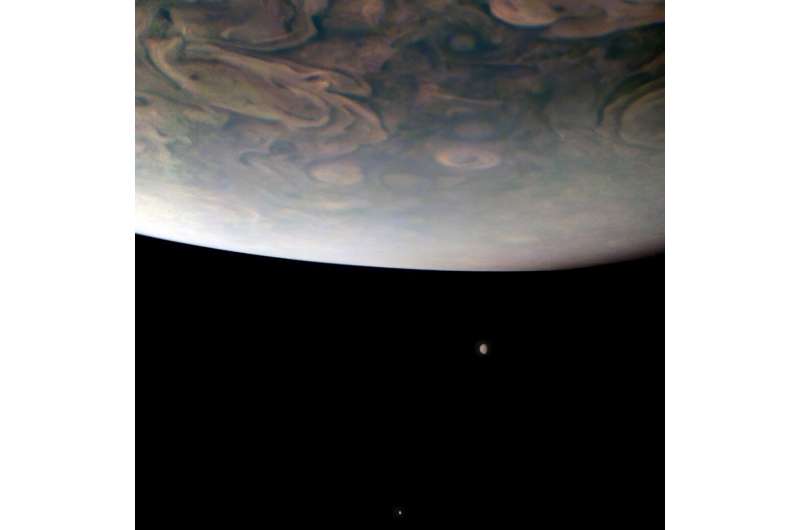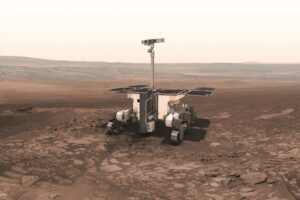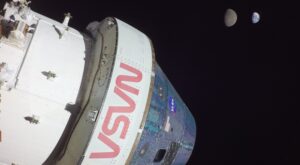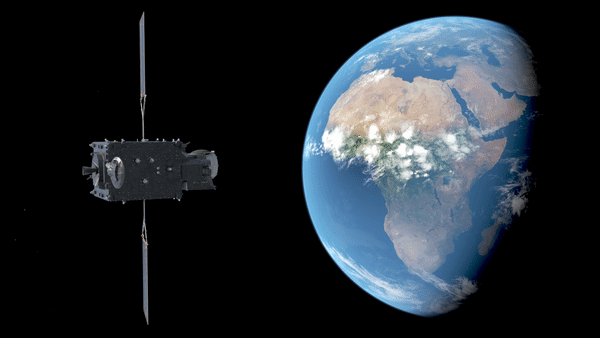Simple semiconductor solutions could boost solar energy generation and enable better space probes
Tuesday, 29 November 2022 16:30 A 'simple' tweak to perovskite solar cells during the fabrication stage could help to unlock the untold potential of the renewable energy source, claims research from the University of Surrey.
Surrey's Advanced Technology Institute (ATI) has demonstrated that by precisely controlling the fabrication process, it is possible to regulate and reduce unwanted energy loss in perovskite solar pan
A 'simple' tweak to perovskite solar cells during the fabrication stage could help to unlock the untold potential of the renewable energy source, claims research from the University of Surrey.
Surrey's Advanced Technology Institute (ATI) has demonstrated that by precisely controlling the fabrication process, it is possible to regulate and reduce unwanted energy loss in perovskite solar pan NASA's Juno mission spots two Jovian moons
Tuesday, 29 November 2022 16:24
On Nov. 29, 2021, NASA's Juno mission completed its 38th close flyby of Jupiter. As the spacecraft sped low over the giant planet's cloud tops, its JunoCam instrument captured this look at two of Jupiter's largest moons.
In the foreground, hurricane-like spiral wind patterns called vortices can be seen spinning in the planet's north polar region. These powerful storms can be over 30 miles (50 kilometers) in height and hundreds of miles across.
Below Jupiter's curving horizon, two Jovian moons make an appearance: Callisto (below) and Io (above).
Juno will make close flybys of Io in December 2023 and February 2024, the first such close encounters with this intriguing moon in over two decades. Io is the most volcanic body in our solar system, and its eruptions leave a trail of material behind that both fills Jupiter's magnetosphere and creates a torus of gas and dust around Jupiter. During the flybys, Juno will study Io's volcanoes and geology, search for signs of a magma ocean, and investigate how Io interacts with Jupiter's giant magnetosphere.
China launches 3 astronauts to complete space station
Tuesday, 29 November 2022 15:13
China launched a rocket Tuesday carrying three astronauts to complete construction of the country's permanent orbiting space station, during which they will expand the facility to its maximum capacity of six crew aboard.
South Korean leader eyes “landing on moon in 2032, Mars in 2045”
Tuesday, 29 November 2022 13:37
South Korean President Yoon Suk-yeol said Nov. 28 that the country will land a robotic spacecraft on the moon in 2032 and on Mars in 2045.
The post South Korean leader eyes “landing on moon in 2032, Mars in 2045” appeared first on SpaceNews.
ESA’s ExoMars plans depend on NASA contributions
Tuesday, 29 November 2022 12:01
While the European Space Agency has secured funding to continue the ExoMars mission for a 2028 launch, that plan requires cooperation with NASA that has yet to be finalized.
The post ESA’s ExoMars plans depend on NASA contributions appeared first on SpaceNews.
Artemis 1 mission reaches halfway point
Tuesday, 29 November 2022 11:07
As the Artemis 1 mission reaches the halfway mark, NASA managers are adding additional test objectives for the Orion spacecraft to prepare for the vehicle’s first crewed flight.
The post Artemis 1 mission reaches halfway point appeared first on SpaceNews.
NASA looks for a new twist on sustainable aviation
Tuesday, 29 November 2022 10:56 For a team of NASA and industry researchers seeking to make aviation more sustainable, it's all about the twist.
No, we're not thinking of Chubby Checker and his signature song and dance. Instead, the focus here is on metal alloys whose molecules literally change shape when exposed to a certain temperature range.
"It doesn't bend out of shape. It doesn't extend. It doesn't shrink. It
For a team of NASA and industry researchers seeking to make aviation more sustainable, it's all about the twist.
No, we're not thinking of Chubby Checker and his signature song and dance. Instead, the focus here is on metal alloys whose molecules literally change shape when exposed to a certain temperature range.
"It doesn't bend out of shape. It doesn't extend. It doesn't shrink. It NASA satellite precipitation data combined with Air Force weather system
Tuesday, 29 November 2022 10:56 Rain gauges are plentiful around the United States, but that's not the case elsewhere in the world - particularly over oceans and sparsely populated areas. That means scientists and other data users have to rely on satellite measurements - such as those provided by NASA's Global Precipitation Measurement (GPM) mission - to fill in the gaps.
The list of data users now includes the U.S. Air
Rain gauges are plentiful around the United States, but that's not the case elsewhere in the world - particularly over oceans and sparsely populated areas. That means scientists and other data users have to rely on satellite measurements - such as those provided by NASA's Global Precipitation Measurement (GPM) mission - to fill in the gaps.
The list of data users now includes the U.S. Air Media invitation: Meteosat Third Generation Imager-1 launch
Tuesday, 29 November 2022 09:15
Media invitation: Meteosat Third Generation Imager-1 launch
ESA ground stations to support first commercial Moon landing
Tuesday, 29 November 2022 09:01NASA Orion capsule reaches farthest distance from Earth in lunar orbit
Tuesday, 29 November 2022 06:03 NASA's Orion space capsule reached its farthest distance from Earth on Monday and successfully completed the first half of a mission that aims to ultimately return American astronauts to the moon.
"Just over an hour ago, Orion set another record clocking its maximum distance from Earth at 270,000 miles," NASA Administrator Bill Nelson announced at 5 p.m. EST on Monday from Johnson Space Ce
NASA's Orion space capsule reached its farthest distance from Earth on Monday and successfully completed the first half of a mission that aims to ultimately return American astronauts to the moon.
"Just over an hour ago, Orion set another record clocking its maximum distance from Earth at 270,000 miles," NASA Administrator Bill Nelson announced at 5 p.m. EST on Monday from Johnson Space Ce IAU CPS Statement on BlueWalker 3
Tuesday, 29 November 2022 06:03 The International Astronomical Union Center for the Protection of the Dark and Quiet Sky from Satellite Constellation Interference expresses concern about the recently launched prototype BlueWalker 3 satellite's impact on astronomy. New measurements reveal that this low Earth orbiting satellite is now one of the brightest objects in the night sky, outshining all but the brightest stars. In addit
The International Astronomical Union Center for the Protection of the Dark and Quiet Sky from Satellite Constellation Interference expresses concern about the recently launched prototype BlueWalker 3 satellite's impact on astronomy. New measurements reveal that this low Earth orbiting satellite is now one of the brightest objects in the night sky, outshining all but the brightest stars. In addit China to launch Shenzhou XV on Tuesday
Tuesday, 29 November 2022 06:03 China will launch the three astronauts of the Shenzhou XV mission to the space station on Tuesday night, according to a program official.
Ji Qiming, assistant director of the China Manned Space Agency, said at a news conference on Monday morning at the Jiuquan Satellite Launch Center in northwestern China that the crew members - Major General Fei Junlong, Senior Colonel Deng Qingming and S
China will launch the three astronauts of the Shenzhou XV mission to the space station on Tuesday night, according to a program official.
Ji Qiming, assistant director of the China Manned Space Agency, said at a news conference on Monday morning at the Jiuquan Satellite Launch Center in northwestern China that the crew members - Major General Fei Junlong, Senior Colonel Deng Qingming and S China to provide training for foreign astronauts
Tuesday, 29 November 2022 06:03 The China Manned Space Agency is doing preparatory work for the training of foreign astronauts to fly aboard the nation's Tiangong space station, said Ji Qiming, assistant director of the agency.
Ji said several nations have expressed to China their wish to send their astronauts to the Tiangong station.
"China is negotiating with relevant parties on this matter. We are actively prepa
The China Manned Space Agency is doing preparatory work for the training of foreign astronauts to fly aboard the nation's Tiangong space station, said Ji Qiming, assistant director of the agency.
Ji said several nations have expressed to China their wish to send their astronauts to the Tiangong station.
"China is negotiating with relevant parties on this matter. We are actively prepa China recruits new reserve astronauts, open to those from Hong Kong, Macao
Tuesday, 29 November 2022 06:03 China is projected to recruit 12 to 14 new reserve astronauts, and the selection, which started in September, is open, for the first time, to payload experts from Hong Kong and Macao, according to the China Manned Space Agency on Monday.
It will be the fourth batch of the country's reserve astronauts. The preliminary selection is currently in progress. The reexamination and confirmation pr
China is projected to recruit 12 to 14 new reserve astronauts, and the selection, which started in September, is open, for the first time, to payload experts from Hong Kong and Macao, according to the China Manned Space Agency on Monday.
It will be the fourth batch of the country's reserve astronauts. The preliminary selection is currently in progress. The reexamination and confirmation pr 
